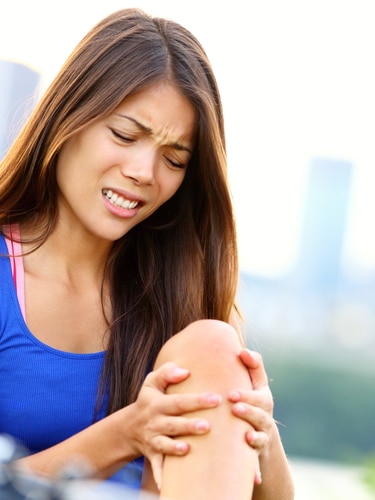
Women Are More Susceptible to Knee Pain than Men
Women are at higher risk for knee pain and injuries than men because of differences in anatomy. Women have wider hips. This increases the angle at which their thigh bone meets the knee, placing more stress on the knee. Women also have weaker ligaments supporting their knees and are more likely to have strength imbalances between their quadriceps and hamstring muscles. In addition, it’s more common for women to have knee caps that don’t fit snuggly with their thigh bones. These factors all place greater stress on the knees and increase the risk of knee pain and injury.
One of the most frequent causes of knee pain in active, young women is patellofemoral pain syndrome. This common cause of knee discomfort is characterized by pain in the front of the knees when climbing stairs, squatting, running or sitting for a prolonged period of time. Otherwise, the knee appears normal with no obvious swelling. High-impact exercises that involve running and jumping make the symptoms worse as do squatting exercises. Symptoms are more likely to be due to degenerative changes and osteoarthritis in older women.
What You Can Do to Reduce the Risk of Knee Pain and Injuries
Since women have anatomical differences that put them at higher risk for knee problems, it’s important to reduce stress on the knees. One way to do this is to correct any imbalance between the quadriceps and hamstring muscles. Women don’t activate their hamstring muscles to the same degree as men during exercise. Strengthening the hamstrings muscles with exercises like leg curls and stiff-leg deadlifts helps to correct some of this imbalance and reduce stress on the knees. Some women with patellofemoral syndrome have weak quadriceps too, so it’s important to strengthen all of the muscles in the lower extremities so they’re balanced.
Wearing shoes with good support and knee supports is another way to protect knees from injury. If you have flat feet a low arch, get arch support or shoes that restrict the motion of your foot. People with low arches have a tendency to over-pronate or turn their foot too far inward when they run, creating additional stress on the knees. A good warm-up before working out and an emphasis on form are also important. Avoid locking your knees during lower-body exercises.
Since women have wider hips and thigh bones set at a greater angle, it places more stress on their knees. A strong hip and core region helps to compensate for this. That’s why core and hip strengthening exercises are so important for women. Balance exercises also help to increase hip and knee stability.
The Bottom Line?
If you’re female, your risk for knee pain and injury is higher. Be aware of this, and use these tips to keep your knees in top shape.
References:
Scand J Med Sci Sports 1995;5:237-44.
Mayo Clinic. “Chondromalacia patella”
NISMAT. “Physical Therapy Corner: Patellofemoral Pain Syndrome”
Related Articles By Cathe:
The Effect of High Impact Exercise on Knee Health
The Surprising Factor That Increases Your Risk of Knee Arthritis
Concerned Because Your Knees Make Noises When You Squat?
Why Are My Knees Hurting? 5 Common Causes of Knee Pain in Active People
Are Women at Higher Risk for Knee Problems?

